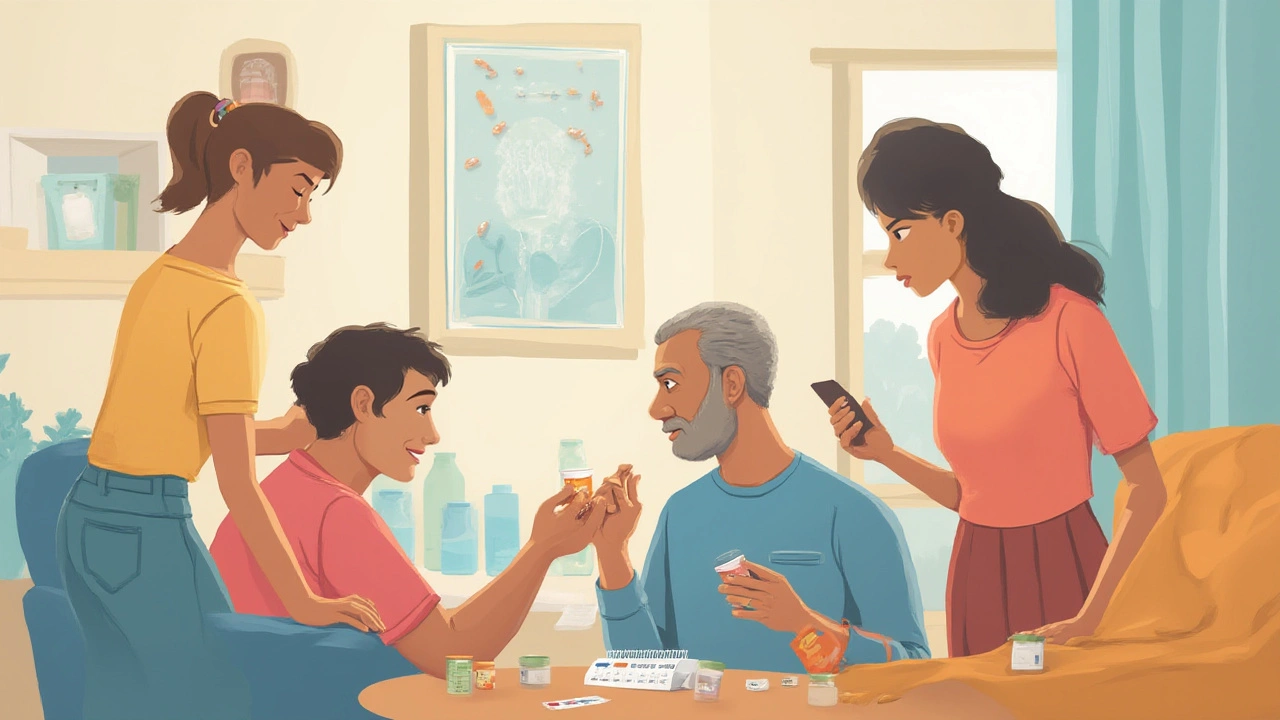Imagine popping antibiotics for a sore throat, hoping the magic pills will wash the sickness away. Now picture this: two months later, you end up with a raging infection that doesn't care about any pill. This odd twist isn’t rare—it's usually a result of misunderstanding how antibiotics work. Misuse isn't just a minor glitch. It’s a global health nightmare, even in places like New Zealand, where access seems easy.
Antibiotics aren’t painkillers for minor aches or miracle cures for every cough. They’re a specific weapon against bacteria, and using them wrong is like spraying weed killer on your daisies. Sounds dramatic, but using antibiotics when you don’t need them breeds ‘superbugs’: bacteria that laugh at common meds. Every year, ‘antibiotic resistance’ kills at least 1.2 million people worldwide. That’s not sci-fi. That’s 2025 reality, backed up by studies from the World Health Organization. That number is climbing, especially in parts of the world where you can buy antibiotics like lollies at the local store. Even in New Zealand, resistant infections have doubled over the last five years, slipping silently into hospitals and homes.
The mistakes usually start small—a forgotten dose, a leftover pill popped for the wrong illness, stopping halfway through the prescription because you’re ‘feeling better.’ Each one can fuel the resistance fire. Sometimes people don’t even realise they’re doing it wrong, because nobody laid out the rules in plain English. That’s criminal, really, given what’s at stake. Let’s zero in on what actually matters for everyday folks: the rules, the risks, and the stuff nobody tells you until it’s too late.
Why Antibiotics Aren’t Always the Answer
Most people catch about two to four colds a year. Google says antibiotics will knock it out, but doctors are strict for a reason: colds and flu are caused by viruses, not bacteria. Picture using a bike pump to inflate a flat car tyre. It doesn’t work, no matter how hard you try. Antibiotics do squat against viruses—so no benefit, just risks. The only time these meds truly shine is against bacterial infections, like strep throat (not the regular sore throat), urinary tract infections, or some cases of pneumonia. Even then, not every cough is a cue to start swallowing pills.
Mixing up the causes is easy. Tonsillitis, ear infections, sinus trouble—it’s hard to know which bug you’ve caught. But here’s a golden tip: only take antibiotics when your doctor says you need them. In 2023, Auckland’s main hospitals had a spike in resistant E. coli cases. The common thread? Self-medication using leftover antibiotics. Those pills left behind in the back of the medicine cabinet aren’t life-savers for mystery symptoms. They’re more like tickets to a world where even simple infections turn nasty.
Pharmacists here are strict about prescriptions, and for good reason, but online shops and travel bring in risky exceptions. People often share pills with friends or buy unregulated meds abroad. These habits might seem harmless after a Bali trip or a dodgy winter, but they undermine everybody’s safety. One strong rule—never use someone else’s antibiotics, no matter how tempting it is when you’re desperate to feel better fast.
One more myth: saving antibiotics for ‘next time’ is smart. Actually, that’s like reusing bandages on a new wound—potentially dangerous and rarely effective. If your doctor prescribes a course, that’s based on the bacteria they’re targeting, the location in your body, and the severity. There’s no ‘one-size-fits-all’ in real medicine, even if it sounds logical online.
Doctors also use lab tests before they prescribe, especially when they suspect resistant bacteria. Ever had a throat swab or urine sample sent away? That’s not bureaucracy. That’s about getting the right match. According to the New Zealand Ministry of Health, almost 30% fewer antibiotics are prescribed now than a decade ago, showing a big shift towards only using them when absolutely needed. This keeps resistance in check and makes sure antibiotics keep working for you (and the people you care about).

How to Use Antibiotics: Simple Rules That Actually Work
Okay—the doctor gives you antibiotics. What next? These aren’t casual supplements; they come with rules, and following them is non-negotiable if you want results and no nasty side effects.
- Finish the whole course: Always. Even if you’re feeling a hundred percent better halfway through, don’t quit early. Bacteria regroup if you stop and can come back even stronger. That’s how resistance starts. A 2022 New Zealand University study found nearly half of Kiwis don’t finish their prescriptions—an easy habit to break with a little attention.
- Stick to the schedule: Most antibiotics work best with even gaps between doses. That could be every eight hours or once a day—never guess. If you forget a dose, take it as soon as you remember (unless it’s almost time for the next one, then skip). Don’t double up ‘just in case’—that could cause more problems than it fixes.
- No mixing with booze: This isn’t a scare tactic. Alcohol can mess with how some antibiotics work and makes unpleasant side effects more likely—think stomach upset, dizziness, or headaches. Always read the label or ask the pharmacist before going for a drink. The classic combination to avoid: metronidazole and alcohol. You’ll regret it even with one beer.
- Don’t share or reuse: Prescription antibiotics work for specific germs. Yours might not help your mate—or worse. Share sympathy, not medicine.
- Watch out for side effects: Some are mild (nausea or diarrhea), but a rash, swelling, or trouble breathing could mean an allergic reaction. Don’t tough it out—call your doctor straight away. Around 5% of people are allergic to penicillin and related drugs. Keep that info handy for next time you need treatment.
- Don’t skip meals unless told: Some antibiotics work best with food, others on an empty stomach. Always follow those instructions. Skipping meals or taking pills wrong can reduce how well they work.
People often get confused by combination meds or when taking other treatments for chronic illnesses. Triple checking with your pharmacist is free, fast, and saves you a headache. One Auckland GP, Dr. Emma Lai, sees patients every week who double up on medications without realising, creating avoidable reactions or blunting the antibiotics’ effect. When in doubt, ask.
Kids need even more care. Dose is based on weight, not guesswork. Leftover syrups lose their strength quickly, so don’t rely on that year-old bottle for junior’s next cold. And remember—never, ever use animal antibiotics. At least three cases in New Zealand in 2024 ended up in hospital after adults tried dog medication for a bad fever. Even pharmacists have heard it all by now.
Storage matters too. Keep pills at the temperatures listed on the label—usually room temp. Refrigerate only if the instructions say. The rain and heat here in Auckland can wreck medicines left in cars or near kitchen stoves. Outdated antibiotics aren’t just less effective, they can be outright risky. Safely get rid of old meds at a pharmacy—never in the rubbish where pets and kids might get curious.
Track your symptoms as you go. If you’re halfway through and not improving (or getting worse), don’t soldier on. Call your doctor—sometimes it’s the wrong antibiotic or a resistant bug. Immediate feedback helps catch issues early and can help public health teams track outbreaks. Digital apps for medication reminders work wonders if you tend to forget doses—tech doesn’t judge, and it can be the difference between a quick bounce-back and a drawn out illness.
Mistakes still happen. Here’s what to do in the most common scenarios:
- Missed one dose? Take it as soon as you remember if it’s within a few hours. Skip if you’re close to the next scheduled time.
- Vomited right after taking a pill? If it’s within twenty minutes, consider taking another (ask your GP to be sure, since it can vary).
- Develop a rash or swelling after a dose? Call medical help immediately—it could escalate fast.
Here’s a handy guide comparing some common antibiotics and their quirks:
| Antibiotic Type | Common Use | Schedule | Typical Side Effects | Food/Alcohol Advice |
|---|---|---|---|---|
| Amoxicillin | Ear, chest, and UTI infections | 2-3 times daily | Nausea, diarrhea, rash | With or without food, limit alcohol |
| Metronidazole | Dental, gut, and skin infections | Every 12 hours | Metallic taste, stomach upset | Never mix with alcohol |
| Doxycycline | Respiratory, acne, and certain tick-borne diseases | Once or twice daily | Sun sensitivity, GI upset | Best on empty stomach, avoid dairy |
If it feels like you’re drowning in details, the bottom line is to respect the process. Antibiotics are powerful tools—one of the biggest game-changers in all of medicine—but they don’t work on autopilot. Teamwork between you, your doctor, and the pharmacist is what keeps them working, both today and for everyone who comes after you.

The Trouble with Resistance: Why Rules Matter More Than Ever
The term ‘antibiotic resistance’ gets thrown around, but it’s less about the person and more about the bacteria. Over time, bacteria learn to outsmart the drugs that once wiped them out. Resistance doesn’t just make infections annoying; it turns what should be a quick fix into a major hospital stay. Picture this: last winter, Auckland Hospital saw three cases of children hospitalised for pneumonia that didn’t respond to standard antibiotics. All three required more expensive, risky IV treatments. It’s getting real, fast.
How does resistance actually happen? Every time you take an antibiotic, the weakest germs die first. But if you stop early—or take antibiotics when not needed—the toughest bacteria survive. They don’t just stick to you. They spread, quietly, to family, to friends, and through the community. Twenty years ago, doctors rarely saw MRSA (methicillin-resistant Staphylococcus aureus) outside hospitals. Now, it’s in schools and sports clubs too.
The easy mistakes are the most dangerous: using antibiotics for stress-triggered headaches, or for chesty coughs that are viral, not bacterial. One recent study even showed that over 60% of antibiotic use in community clinics across New Zealand was for illnesses that wouldn’t have improved with them. Each unnecessary dose is a crack in the armor of our medical system—a gap the bacteria can sneak through.
When ‘superbugs’ get going, the options get slim. Doctors have to reach for second or third-choice antibiotics. These are often more toxic, less effective, or need to be given in a hospital. The family member with a routine surgery, a friend going through chemo, or a child with a cut—they’re suddenly at risk of serious complications from bugs we used to shrug off.
This fight is personal. Staying sharp about your own prescriptions makes a difference, not just for you, but for the whole community. Maybe you’re the type who’s never missed a pill. That’s solid. But playing backup for neighbors and relatives (especially older folks who may forget) can help prevent disasters. Encourage reminders, double-check dates on pills, and make sure nobody is keeping half-finished courses just in case.
Public health campaigns in New Zealand run reminders each winter. Common messages: if you’re prescribed antibiotics, you really need them. If you weren’t, don’t beg for them, and don’t go online for black market meds. Community efforts work—several Auckland schools have pressure-tested programs for teaching kids to tell the difference between colds and real infections. Kids learn fast, and often end up schooling their parents. There are even interactive pharmacy displays during Kiwi Antibiotic Awareness Week, showing what resistance looks like (think Petri dishes full of stubborn bacteria refusing to budge).
On a global scale, governments are tracking the amount of antibiotics used. In 2022, the OECD put New Zealand in the middle of the pack for use, but called out a concerning uptick in animal antibiotics drifting into the human supply. Simple steps—washing hands after handling raw chicken, not demanding antibiotics for every bug, and finishing prescriptions—help blunt the rise of resistance.
So next time you’re clutching a box of pills with a sore throat or a hacking cough, remember: you’ve got to use antibiotics the right way, every time. It’s not just about feeling better soon, but about making sure everyone else can too. That’s something worth sticking to.



Comments
Alright, folks, here’s my hot take on antibiotics—like, who actually remembers to finish the whole damn course? I swear, half the population just stops when they 'feel better' and wonders why things get worse. Spoiler alert: that's exactly how resistance kicks in! Seriously, if you think skipping doses is no biggie, you’re basically giving bacteria a free pass to evolve into supervillains.
Also, anyone else always confused about the timing? Like, do I take it right after breakfast or after some random snack? These simple rules in the post sound nice on paper but sometimes it feels like rocket science.
But hey, staying informed is cool and all. So, anyone here had a wild story about their antibiotics journey?
I totally get where you're coming from with the confusion around timing! It’s quite vexing sometimes when the instructions are all vague-ish like 'take with food' but doesn't say what kind or how much. I just try to stick to a routine that fits my day best, even if it means taking it a little later than recommended.
Also, there's a bit of worry about antibiotics causing more harm if used wrongly, so it’s nice to be reminded about being careful. Sometimes I wonder if waiting a bit before starting them (if symptoms aren’t wearisome) can help avoid unnecessary use?
Not to mention antibiotic resistance is something we all should think about deeply, it’s a scary prospect when bacteria outsmart meds, right?
Great points both! I often ask my doctor if there are any non-antibiotic options before jumping in. Antibiotics are powerful, but their misuse does way more harm than good.
Regarding timing, consistency is key, and that’s what I emphasize with friends and family. Taking doses roughly the same time every day is easier for me than trying to remember vague rules like 'take with food'.
Plus, one thing that surprised me recently is how some foods or supplements can interfere with antibiotics. It’s definitely worth researching or asking a pharmacist about these interactions.
Man I love how sometimes the simplest advice can be the hardest to follow. Like, yeah, don’t skip doses, finish the course, but life gets hectic! Who remembers the exact timings especially if you’re on multiple meds?
But honestly, kudos to whoever made this guide. Easy to understand rules can save a lot of headaches. I’m all for making healthcare less complicated with straightforward stuff.
What really gets me is how antibiotics aren't magic cures for all infections, too many people treat them like candy.
Oh please, the drama about taking every pill on time like some holy grail. Sure resistance is a big deal, but ever thought about the number of antibiotics pushed unnecessarily by doctors just to cover their bases? That’s equally scary. And how these guidelines serve more like scary bedtime stories for patients than practical use.
Sometimes, the real world doesn't match neat schedules or 'simple rules.' People forget, meds can mess you up too, so it’s about balance, not blind faith.
Does anyone else feel this post’s tips would be more effective if mixed with some reality about side effects and patient challenges?
While the article does attempt to demystify antibiotics usage, I must say it grazes only the superficial layer of a profoundly complex pharmacological and sociopolitical landscape. Our obsession with such 'simple rules' conveniently sidelines the vast disparities in healthcare literacy, accessibility, and the cultural myths that circulate, especially in less urbanized areas.
It is imperative to educate beyond just dosage schedules. Patients must grasp the nuances of microbiological resistance mechanisms, implications of incomplete adherence, and the silent epidemic we are nurturing unknowingly.
I wish such guides were complemented with narrative case studies illustrating failures due to non-adherence and systemic healthcare education reform.
Ugh, I’m always the grammar nazi about meds info. Can’t tell you how many times I’ve seen 'antibiotics' spelled wrong in serious places. Good for the guide for not butchering textbooks here.
Aside from spelling, the dos and don’ts are crucial. Seriously, people, finish your course! It’s non-negotiable. Skipping doses isn’t just a minor mistake; it’s practically gifting bacteria a PhD in survival.
Plus, mixing up antibiotics or doubling doses trying to ‘speed up’ recovery? Stop that nonsense fast.
This reminds me of when I just chill and take antibiotics whenever I remember—bad habit, I know. Got lucky sometimes, but that’s not gonna fly in the long run. This guide rules for bringing some order to the madness.
Honestly, just setting alarms helped me a lot. Otherwise, who can keep track with work and life? Also the bit about antibiotic resistance really hit home after reading some articles.
Would be cool if there was an app that just made taking meds idiot-proof.
Oh boy, reading all these comments, I gotta say some people here act like finishing an antibiotic is rocket science. Like, seriously, how hard is it to down a pill a couple times a day? Apparently, very hard when we have outbreaks of resistant infections.
Also, not to be that person, but skipping doses and not taking antibiotics appropriately isn’t just foolish; it’s borderline selfish. You’re risking not only your health but everyone else’s. That’s the tea.
And please stop asking if you can just quit when you feel better—NO. Just no.
Resistance crisis? Yeah right, widely hyped by pharma companies to boost profits on newer antibiotics. I’m skeptical about all these 'simple rules' because honestly, like what if the guidelines are conveniently ignoring side effects or individual differences? One size fits all rarely works in medicine.
Also what about alternative therapies, natural remedies with fewer consequences? I bet they get laughed off the table every time.
We need more balanced conversation on when antibiotics are truly necessary, not just another push to use 'em like candy.